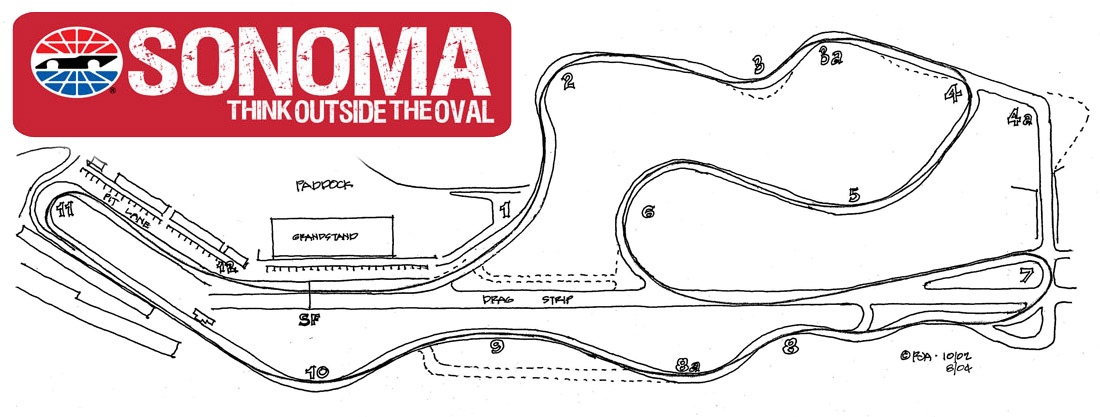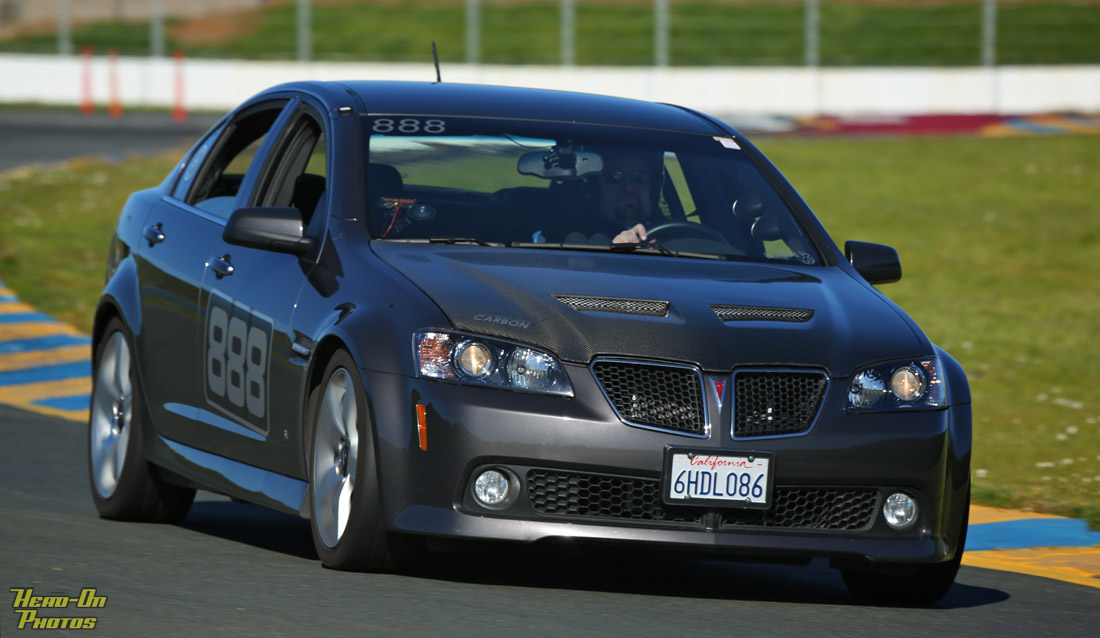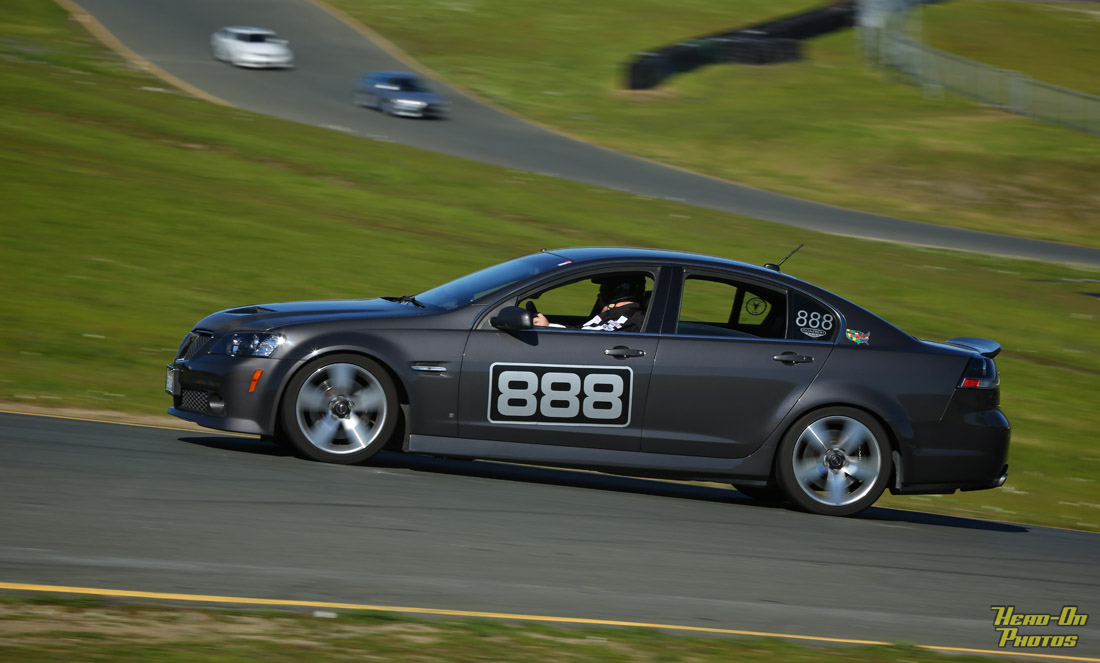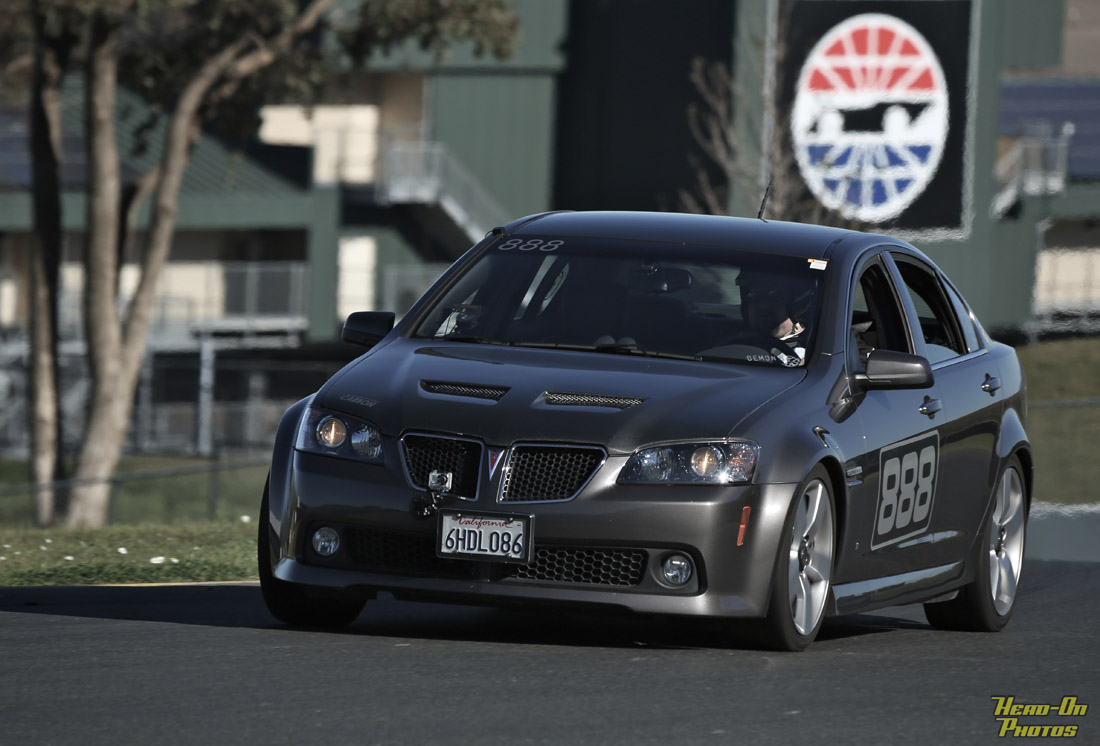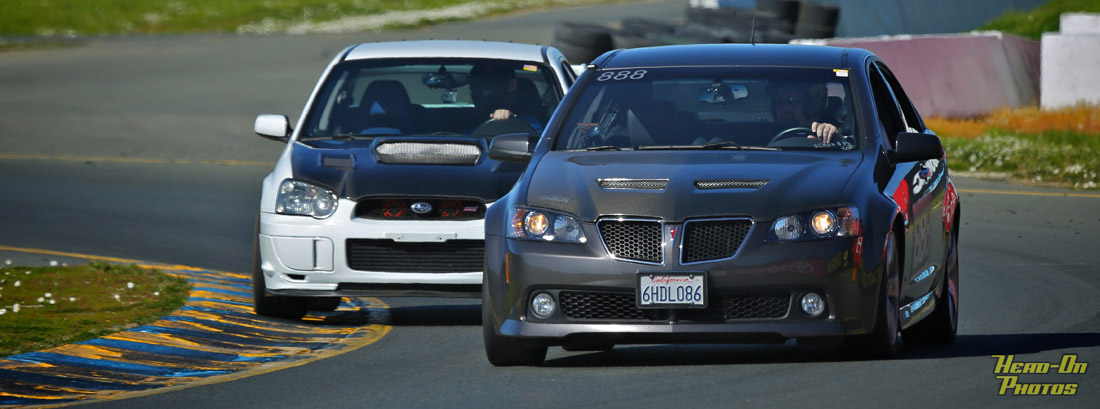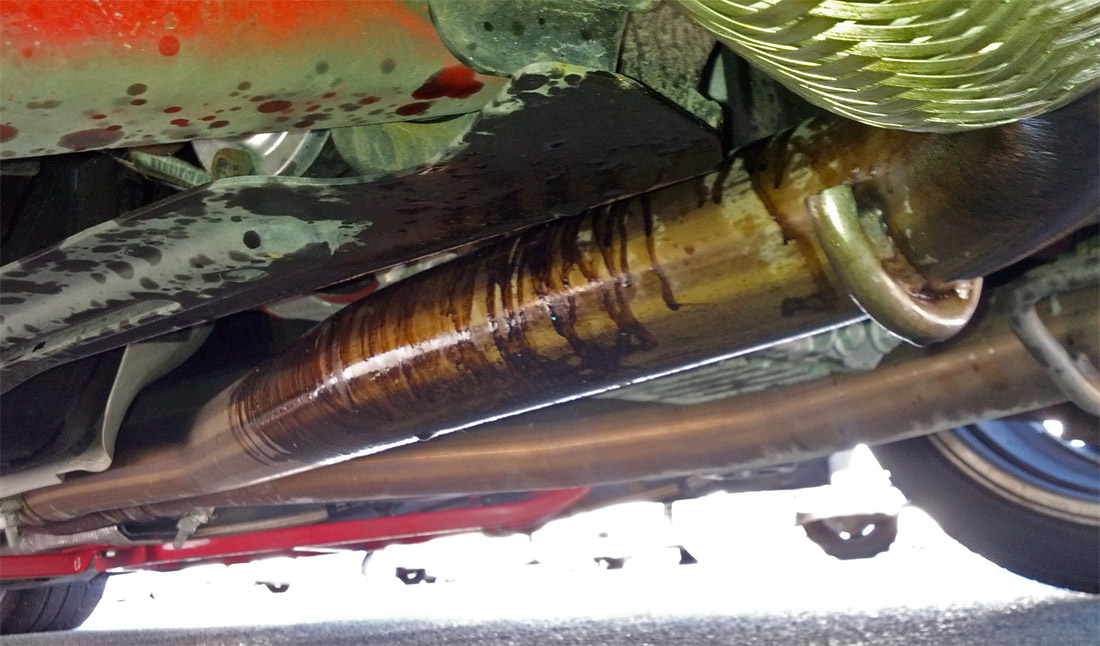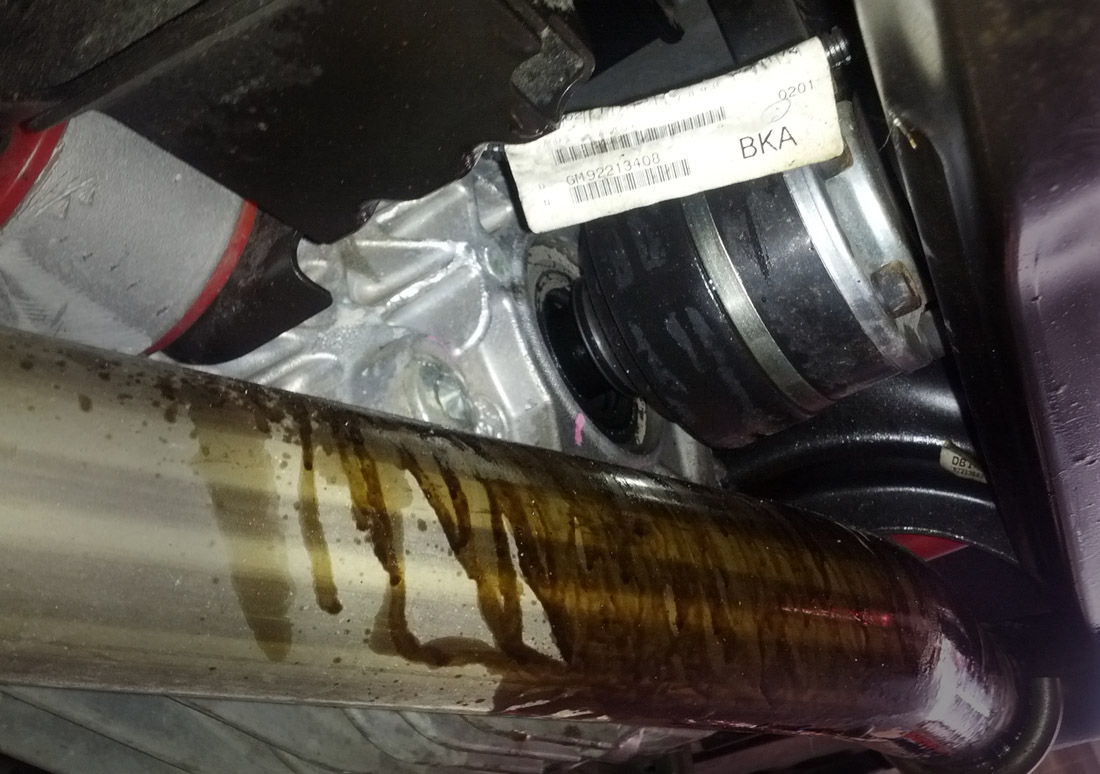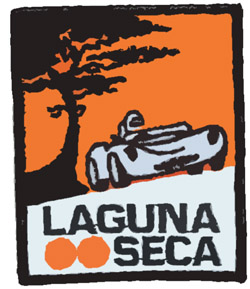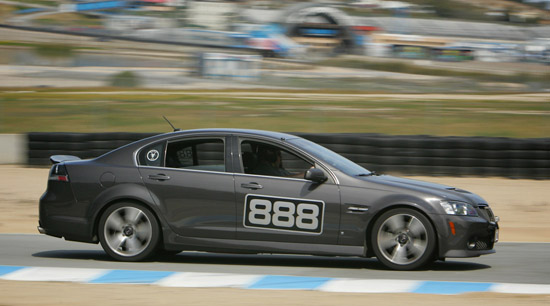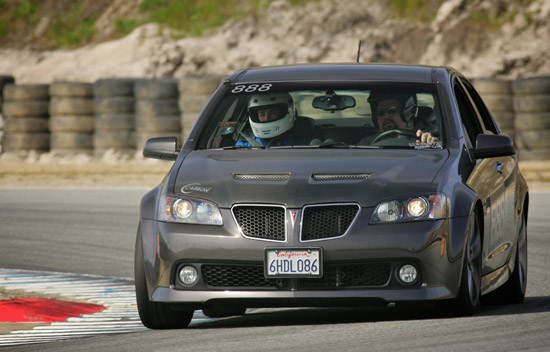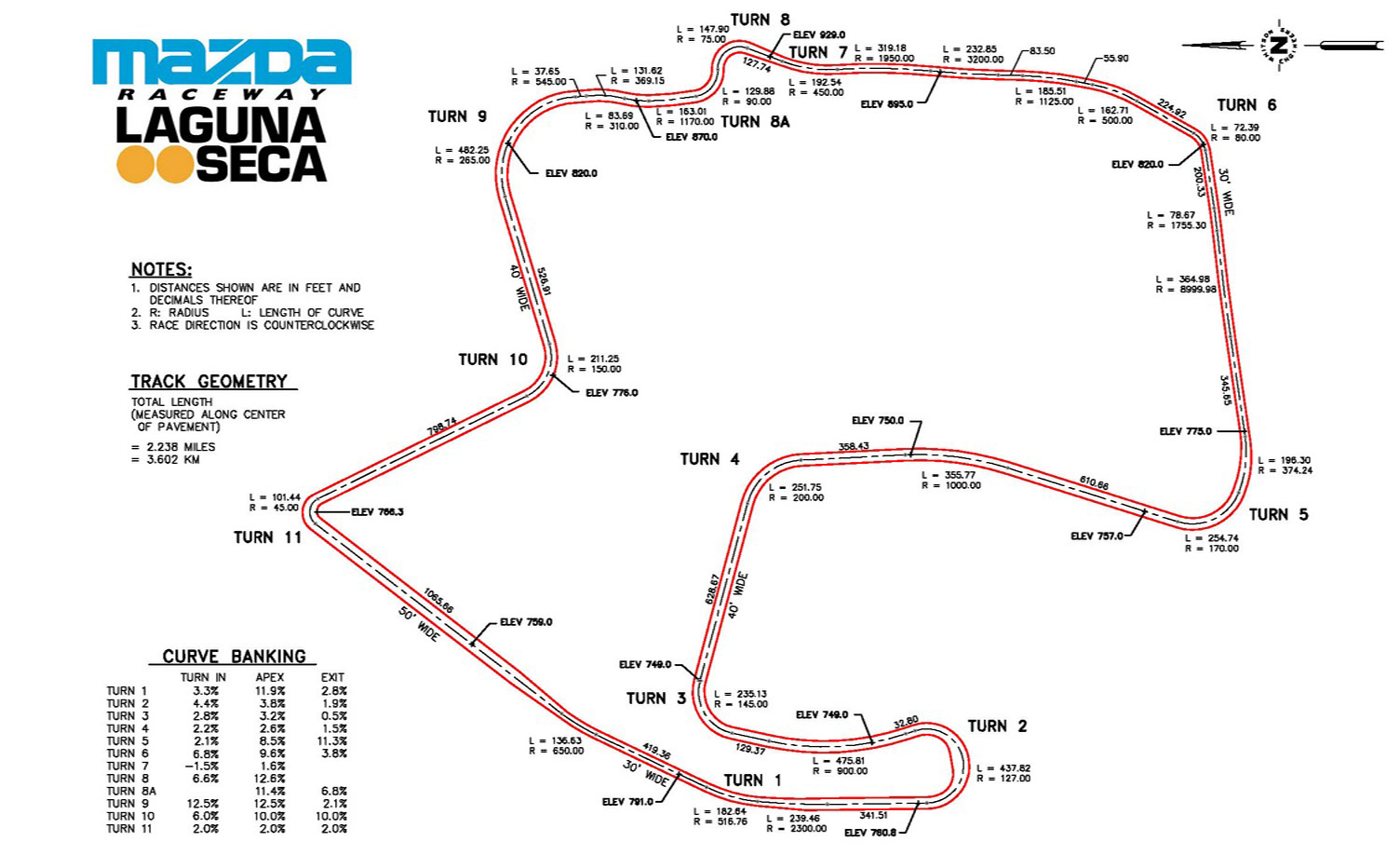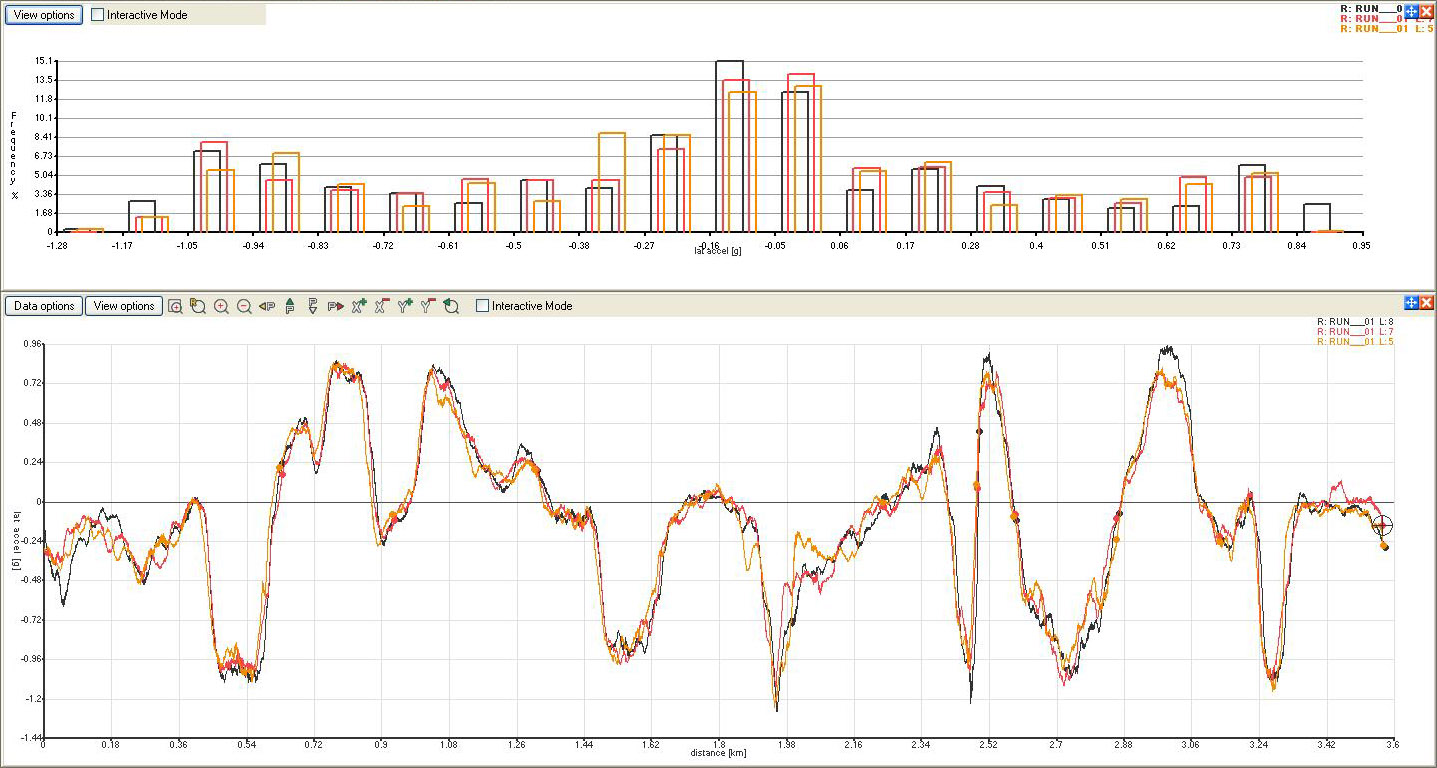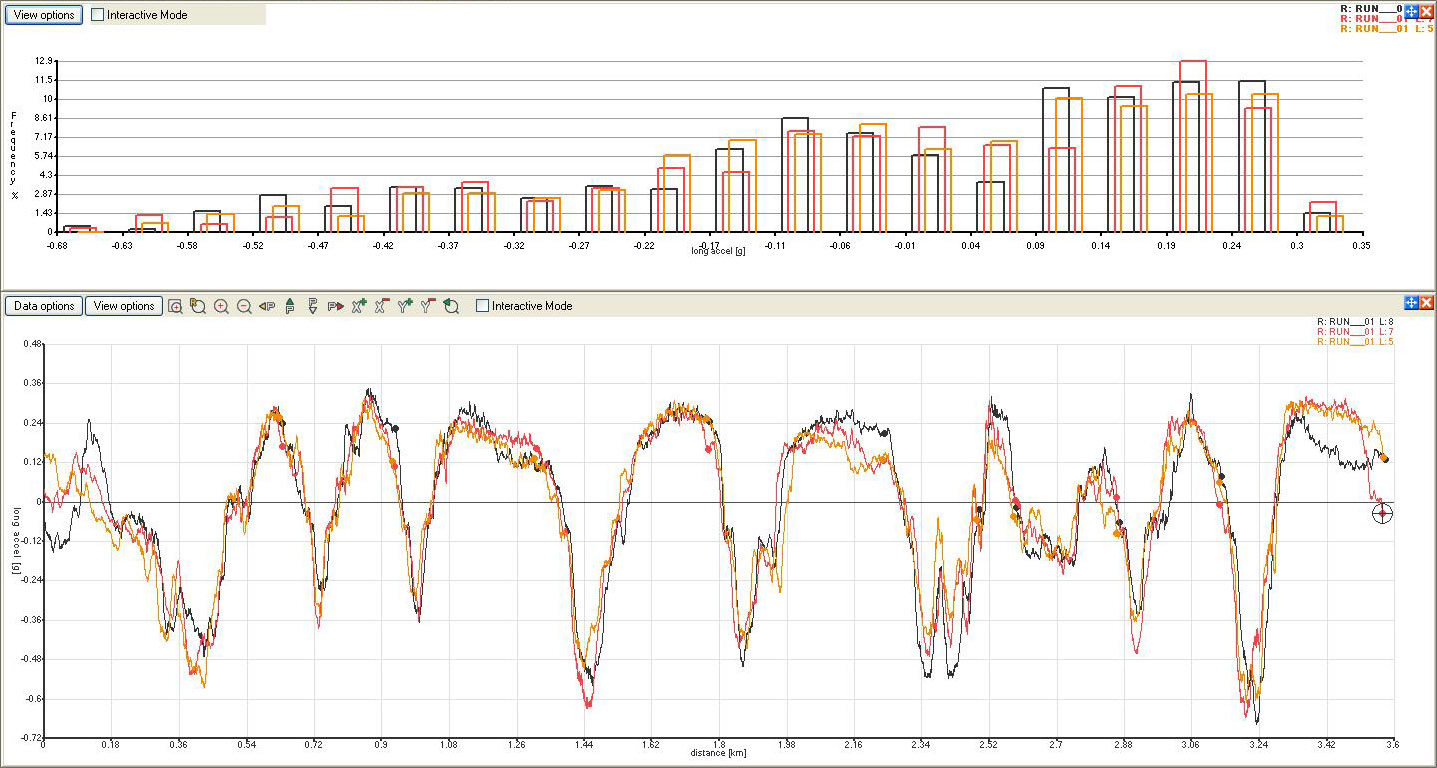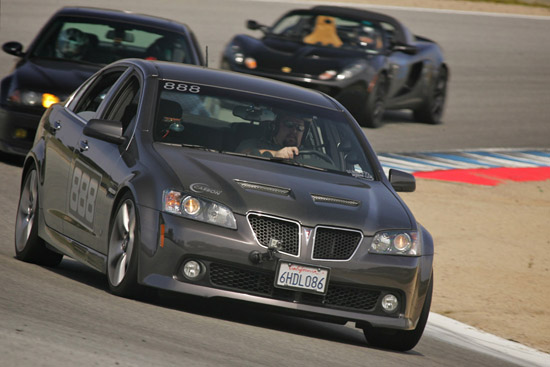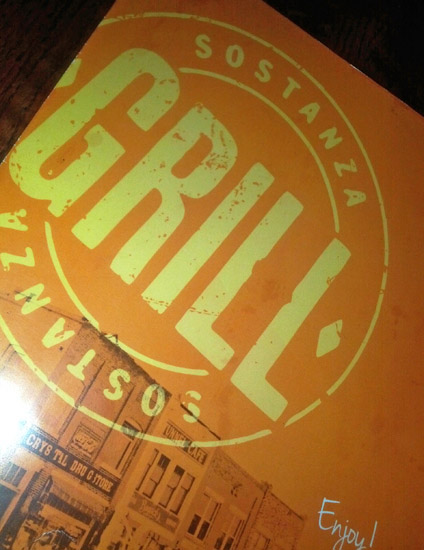-
G8 at Sonoma Raceway!
Posted on February 10th, 2013 No commentsLast April I had the chance to take the G8 out on-track at Laguna Seca Raceway. While it was lots of fun, the event ended early on a sour note when my engine started making disturbing noises. Shortly after the rebuild I headed-out on my 2012 GONE Road Trip, so have not had a chance to return to the race track in nearly a year!
Determined to return to the track, I’ve spent the winter trying to organize a group of G8 and GTO owners who want to participate in track day events. My goal is to help facilitate the process for those who have never done it before, so have spent many hours checking calendars and putting together guides/checklists. After careful deliberation I decided that I would attend a two day track day event with the Northern California region of the National Auto Sport Association (NASA) at Sonoma Raceway (aka. Sears Point).
In Northern California NASA is one of the largest groups of driving/racing enthusiasts and typically have a weekend event every month at the various tracks. Most event include both High Performance Driver Education (HPDE) events as well as full-out racers. The HPDE drivers are broken down into four groups based on experience:
- HPDE-1: Novice – Instructor assigned, passing on main straights only
- HPDE-2: Solo – Runs with HPDE-1, passing on main straights only
- HPDE-3: Intermediate – Passing areas more liberal and increasing as day progresses
- HPDE-4: Advanced – Open passing
Sonoma Raceway (previously known as Infineon Raceway and Sears Point Raceway) is a tricky track. While there isn’t anything as extreme as “The Corkscrew”, the track is not a bunch of individual corners connected by straights… rather every corner flows into another. Making a mistake on the entry to one corner results in a cascade of problems through half the track. When you do things right you can really feel the rhythm of the track, and that’s extremely addicting!
Having never driven with NASA, or at Sonoma Raceway, I decided to take things slow and run in HPDE-2. I’m sure I would qualify for HPDE-3, but didn’t want to overstep my abilities and make a bad first impression. It also gave me a chance to help the new HPDE-1 drivers who had never been to a track day event before.
The week before the event I took the G8 into Synergy Motorsports for routine service (oil change, etc.) and a thorough once-over to make sure everything was ready for the track. After a year (and ~15k miles) I also had the brake fluid replaced (with more Castrol SRF)… the brake pads still had 50% of the material remaining. I also had replacement OEM front LCAs installed (I had reinstalled the original ones after reports of failures with the aftermarket ones).
Given the event was both Saturday and Sunday, I decided to get a hotel close to the track so I could avoid the hour-long drive to/from the track each day… with the gates opening at 6am I figured the little extra sleep would be nice. It was also fun sleeping in a room with posters of Ferrari’s on the wall and a track map above the bed!
I took Friday off so I could prepare for the weekend event. I took advantage of a gorgeous “winter” day in California to wash the G8 before heading-up to the hotel. Most of the day I had a nervous feeling in my stomach, but I knew it was just anticipation.
Day #1
Compared to my previous track day, NASA was definitely “strict” when it came to the rules. This isn’t a bad thing, especially since there were quite a few people who had never driven on-track before. After taking some time discuss basic information they went over flags then broke-down into the various HPDE groups for more in-depth discussions before getting out on-track.During the first 20 minute session of the day I started near the back of the HPDE-2 drivers, but in front of the HPDE-1 group. One of the nice parts of NASA events is that while HPDE-1 and 2 are limited to passing on the main straights, no point-bys are required. While this resulted in some sketchy passes by impatient drivers, I found it nice to feel like I wasn’t ever holding-up people.
After letting one person by I had nearly the entire session to work on learning the driving line. I’d spent quite some time reading track guides and practicing in video games, but there is nothing that can replace the experience of driving around a corner. While I’m sure my line was far from ideal, I felt I was starting to develop a good sense for where I needed to be.
Towards the end of the first session the flag stations started to display a black flag (“Black Flag All”) meaning we were to proceed (with caution) around the track and return to the pit lane. As I rounded Turn 7 I spotted a standing yellow flag and a white flag (slow moving vehicle on-track). As I entered Turn 8 I could see a vehicle sitting off-track at the apex of Turn 8a, but it appeared to have damage on the driver’s side door. I kept thinking to myself, “How did you do that there? There’s nothing to hit…”. Then I spotted a Porsche with front-end damage hiding behind a safety truck.
After each HPDE session on-track NASA has a group “download” session where we discuss things. Needless to say there was quite a lot of discussion about the car-to-car incident (which is nearly unheard of). It was obvious to me that people were driving too fast/close for their ability, especially for the first session (of the first event of the year). It was a bit surprising to hear the instructors comments about who was “at fault” in the incident… and that as a driver you are responsible for being able to control/stop your car if/when the vehicle ahead of you has an issue (like a spin).
There wasn’t much time after the debrief before we were back out on track for the second session of the day. I again tried to position myself towards the end of the HPDE-2 group, giving myself lots of room to work on learning the track.
Like I did in the driving schools I decided to keep in 4th gear and just focus on the line. I found that I was picking-up things fairly quickly, but knew I wasn’t pushing too hard. While I started going WOT on the straights, I tried to be consistent with my braking/turning points. Just when I was getting in the groove the session came to an end.
At lunch NASA runs a session called a “Hyperdrive”. This is designed to give people a taste of track driving without all the requirements of a full HPDE-1 run group. Many people would consider a 45 minute track session at a maximum speed of 35mph torture, but with no previous experience/instruction at Sonoma Raceway I took this as the perfect time to really learn the driving line with one-on-one instruction. Unfortunately the debrief from the second session ran long, so I missed half of the Hyperdrive, but I came away from it with a much better understanding of the track. I would highly recommend it for anyone really looking to learn to drive a new track.
Before the third session I needed to fill-up my tank with fuel. With the G8 tuned to run on 91 octane pump gas there isn’t a need for race gas, but during long sessions engine/intake temperatures can get high. Running higher octane fuel is cheap insurance to protect against detonation (or the ECM pulling timing due to knock). After 12.424 gallons of 96 octane (at $7.999 per gallon) the final “blend” in the tank was 94.8 octane… perfect for an afternoon of track driving!
In the third session I planned to apply what I’d learned during the Hyperdrive and really work on driving the proper line. I came up-to-speed more quickly and soon found myself starting to push things harder down the straights and through the corners.
Just when I was starting to get a feel for the track I entered Turn 10 something went wrong…
As I looked into my rear-view mirror to check on the car I was going to let pass me I noticed a bunch of smoke coming out the rear of my car. At first I thought I might have lost traction somehow, but I wasn’t on the gas. Fortunately the entrance to pit lane was just to the left, so I quickly exited the track.
In the paddock I checked the G8’s vitals. Oil pressure and temperatures both looked good, oil level was good. Unlike last time I had issues on-track there were no strange noises. The engine seemed to be OK, but I wanted to find a cause for the smoke. I remembered that I hadn’t checked my catch can prior to the event… and sure enough there was quite a bit of oil in there. At that point I figured I’d found the problem (some oil had been picked-up from the catch can and been sent into the intake, resulting in smoke). In hindsight I really should have crawled under the rear of the G8, as I would have noticed that hadn’t been the case.
Despite thinking I’d fixed the reason for the smoke, I didn’t want to push things and drive in the fourth session for the day. I took a trip out on the ring road to see if I could see any more smoke and to double-check that everything was behaving. I wasn’t experiencing any issues, so after watching the Group C race I headed back to the hotel for the night.
Day #2
Yesterday was an exciting day, but after the mechanical issues from Session 3 I was apprehensive about how the day would go. I’d driven to/from the hotel without issue, but I wanted to take things slow on-track so arranged to be one of the last cars out for the first session.I started out of the pits and everything seemed to be OK. I made my way around the track on the opening warm-up lap slowly increasing the speeds, but just as I started around Turn 10 I knew something in the drive-line was not right.
As I tried to accelerate out of the corner I could hear the engine RPMs increasing, but there was zero power going to the rear wheels. I had another car on my bumper, so quickly dove into the pit lane while I tried to find a gear that would work. After trying a few different gears with no luck, I knew my weekend was over. I coasted into the paddock and quickly located an empty area to park. I pulled-off my helmet and crawled under the back of the G8 to figure out what had happened.
At this point I could clearly see it was something major that caused the smoke yesterday, not just a little excess oil from the catch can. Fortunately one of the steps I’ve taken in preparation for track driving is upgrading to a Platinum AAA membership which includes up to 200 miles of towing per incident.
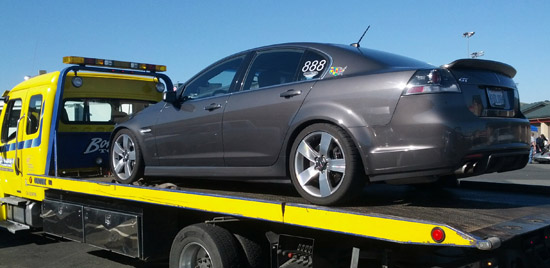
It didn’t take long for the tow truck to arrive and get the G8 loaded-up. After swinging by my spot in the paddock to pick-up all my stuff (tools, bags, spare tire, etc.) we headed-off towards my mechanic’s shop.
Getting the G8 up on a lift, it’s was obvious there is something wrong with the rear differential.
The driver’s side axle had separated from the differential and that allowed fluid to drip onto the exhaust (causing the smoke observed on-track). Fortunately it appears there was no damage caused to the axles or the differential and after flushing the fluid everything went back together and seems to be driving fine.
Overall it was a fun weekend. It was great to drive at Sonoma Raceway with NASA and I was glad I could help some friends get out on track for the first time. While I would love to get back out on-track soon, finishing on a tow truck wasn’t how I imagined it ending. I said after my previous track day, I really think I need to look into a dedicated track car!
-
Post-Rebuild Test & Tune
Posted on November 3rd, 2012 No commentsHaving recently having my engine rebuilt, which resulted in a 21% increase in power, quite a few people have been pestering me to get to the drag strip. I’ve been avoiding it since I couldn’t get traction on my street tires before the upgrade, but since the NorCal GOATs were going to Sacramento Raceway for a Test & Tune I figured I’d go have some fun.
The days leading-up to the event I wasn’t sure if I was going to run the G8 or not. Towards the end of my road trip I developed a nasty “shimmy” in the front-end between 70-80mph, and wasn’t going to race if it continued. Fortunately the new tires fixed the issue (I still think there might be some LCA issues to fix) and I felt comfortable taking the G8 down the strip.

The weather today was good, but not as cool/dry as I had hoped. By noon, when they started to run, the DA was up to 478′ and it progressively climbed thorough the day to 914′ by the final runs. Not bad for California, but not great.

My best run of the day came just leaving the G8 in “Drive” with the traction control turned on. I rolled into the throttle from idle and just let the computer do the work. The result was a 12.007 @ 116.10mph… not bad for a 245-series street tire!
My 60′ time was 1.934sec, five-hundredths of a second faster than launching in 2nd with TC off, but I could feel the traction control pulling timing in 1st gear and between the 1st to 2nd gear change.
I’m very happy with my results. Would it have been nice to run in the 11’s? Yeah, but I’m not going to go crazy searching for a time. Looking at my trap speeds there are still a couple tenths left in the car… if I was ever wanted to get serious about drag racing.

My favorite part of all of this is just how “well rounded” my G8 is. I can run 2 minute lap times around Laguna Seca, 12 second passes down a drag strip, and drive 11,000 miles across the country without changing anything!
-
CFRA Member!
Posted on April 19th, 2012 No commentsLast week I attended a Checkered Flag Racing Association (CFRA) event at Laguna Seca as a guest. Seems like I made a good impression, as today I was invited to become a member!
Now I really want to get the G8 fixed-up and ready for the track… there is another CFRA event at Laguna Seca coming-up at the end of May!
-
G8 at Laguna Seca Raceway!
Posted on April 9th, 2012 No commentsToday was the first time I’ve taken taken G8 out on-track, and I couldn’t think of a better place in the world to do it on than the iconic Laguna Seca Raceway in Monterrey, California.
I had originally planned on attending my first track day at Thunderhill Raceway, due to the lower risk of damage due to off-track excursions (aka. the walls are farther from the racing surface). When I heard that the Checkered Flag Racing Association (CFRA) was inviting guests to a Laguna Seca track day (and for only $99 after 50%-off) I just couldn’t resist!
I have a very long-standing relationship with Laguna Seca Raceway; attending races there since before I was born! I’ve been told the story of how my Father helped my Mother (7 months pregnant) up the hill to The Corkscrew. When I was a child I was running around the paddock checking-out all the historic race cars… including a memorable experience with Sir Jackie Stewart. I attended my first professional race at Laguna Seca in 1993 where I saw Paul Tracy win the race and Nigel Mansell win the CART Championship. Laguna Seca Raceway was also a track I photographed on a regular basis (23 different events between 2003-2008).
CFRA is a “members only” group who got together to organize and attend, not-for-profit, track day events. One of the primary goals of the group is to maintain a safe and courteous environment for driving/racing on-track. They have three run groups (resulting in 2.5hrs of track time each event) at various levels of competitive ability/desire.
For this event CFRA was not taking any drivers who had not previously been on-track before. Group B (point-by passing) was for drivers with fewer than 10 days experience and Group A (open passing) was for those with more than 10 days experience. There was also a Group R for those with lots of experience and who wanted to do wheel-to-wheel racing (aka. not me).
While I’ve never done a track day, each of my driving schools counted for several days of experience, and I was invited to join Group A for this event. While I’m sure I would have done a good job in Group A, I decided that I wanted to take things a little slower… especially for the first time out in the G8. As a result I didn’t get the 50% discount (all the discount spots for Group B were already filled), but I felt being in the right group was worth a couple extra bucks. In the end I made the right decision, as I took things slow and probably would have been getting in the way of the faster drivers of Group A.
 Another really exciting thing about this event was that Dito Milian of gotbluemilk.com was photographing the event. Dito and I have shot quite a few events together, so I knew I was going to get some really great photos!
Another really exciting thing about this event was that Dito Milian of gotbluemilk.com was photographing the event. Dito and I have shot quite a few events together, so I knew I was going to get some really great photos!CFRA events are not really focused on teaching someone how to drive on a track (there are other groups/schools for that), but they do offer “mentors” to ride-along with other drivers. During my first session I requested a mentor, as I wanted to make sure I could quickly get up to speed.
The first couple laps on-track I took things really slow, really focusing on trying to drive the proper line around the track.
Most of the corners at Laguna Seca are late apex, so really make you be patient on turn-in. Fortunately most of the corners are also banked, letting you carry a bunch of speed through them. Building on what I learned at Miller Motorsports Park, I made sure to get my braking done early… so I could get the car turned-in… and back on-power as quickly as possible. There were only a few times that I found myself carrying too much speed into the corner without the ability to get the car turned.
Unlike the tracks I’ve previously driven on, Laguna Seca has huge elevation changes and many blind corners… making navigating the course quite difficult. Every driving school I’ve been to has really focused on vision and keeping your eyes scanning where you want to drive. At Laguna Seca I found that 7 of the 11 corners had some sort of “blind” element…
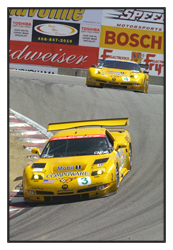 The ultimate example of this is “The Corkscrew” (Turns 8 and 8a), which is a left/right turn combination that drops 59 feet in elevation (the equivalent of a five-and-a-half story drop) over only 450 feet of track. As you drive up the hill towards Turn 7 all you can see is sky until you crest the hill. To the left at Turn 8 there is a wall/fence and corner worker station that makes seeing the rest of The Corkscrew impossible. After slowing the car down (in my case to ~30mph) you turn into the apex of Turn 8… with absolutely no view of the right hander (Turn 8a) to come. It is not until you have already committed to a line, and dropped into The Corkscrew, that you have any idea if you’re on the proper course.
The ultimate example of this is “The Corkscrew” (Turns 8 and 8a), which is a left/right turn combination that drops 59 feet in elevation (the equivalent of a five-and-a-half story drop) over only 450 feet of track. As you drive up the hill towards Turn 7 all you can see is sky until you crest the hill. To the left at Turn 8 there is a wall/fence and corner worker station that makes seeing the rest of The Corkscrew impossible. After slowing the car down (in my case to ~30mph) you turn into the apex of Turn 8… with absolutely no view of the right hander (Turn 8a) to come. It is not until you have already committed to a line, and dropped into The Corkscrew, that you have any idea if you’re on the proper course.While I’ve driven Laguna Seca many times in video games, watched lots of in-car videos, even walked-up/down the track… there is absolutely nothing like doing it from behind the wheel of a car. The first time I entered The Corkscrew I made sure to slow way down, and even turned-in more than I thought I would need to… only to find my two right wheels on the rumble strips through Turn 8a. While it was an awesome line, it sure was a surprise… especially when I thought I was being conservative!
As the session progressed the speeds increased and my lap times decreased. Unlike the driving school, this time I had my Race-Technologies DL1 running… and gathered some really great data (click images to see them full-size).
Lat. Acceleration (Left/Right)
Lon. Acceleration (Front/Back)
Looking at the data I’ve been very impressed with how the G8 performed. Lat. acceleration was more than I was expecting (especially for a street tire) with several sustained periods each lap over 0.75 G’s with peaks as high as 1.25 G’s. While the Lon. acceleration wasn’t as extreme, under braking I was experiencing 0.4-0.6 G’s and ~0.25 G’s while accelerating. I can only imagine how this numbers will compare when I get more experience (and a 275/35-18 Hoosier slick)!
For the second session I was on-track without a mentor… without anyone to guide me around the track… on my own!
Driving solo was actually kinda relaxing… I didn’t have the pressure of needed to “show-off” or drive “perfect”. I felt like I kept things slower, again to perfect the driving line, but the the data actually showed I was within 1 second of my fastest first session lap after only two laps!
Between session… after I had double-checked the tire pressures, oil levels, etc… I decided to put a camera on the front of the car to record some video. Here is a video of a typical lap around Laguna Seca.
As the second session progressed I felt I was really getting a hang for the driving line, as well as feeling-out how the G8 handles on-track. I found myself being able to put together several laps without having any major “oops” moments. My lap times were in the ~2:00 range, which wasn’t great, but for only my second session at Laguna Seca wasn’t too bad. I also knew that while I gained a feel for the G8/track I wasn’t pushing 100% down the straights and was taking it easy in the braking zones.
Unfortunately, late in the second session, as I crested the hill on the front straight I heard my engine start making a strange “ticking” noise. As I exited Turn 2 I heard the car beep, indicating a check engine DTC. On my run up the back straight I again heard the noises, so I backed-off and made my way into the pits. Here are clips from the front mounted video camera, where you can clearly hear the “ticking” noise.
Once I made it to the pits I checked/cleared the DTC (P0300 “Random Misfire Detected”) and tried to replicate the sounds/DTC. I was unable to, as there is a 4,000 rpm limiter in park, but when got the engine over ~4,500 rpms in 1st and 2nd gears I was able to replicate the noises and the DTC. Rather than risking further damage to my engine, I made the decision to park the car for the remainder of the day.
Despite only having two sessions on-track, I drove ~50 miles and used half a tank of fuel… yup, I was getting ~6.25 miles per gallon!
While I didn’t get a chance to spend the afternoon out on-track, I took advantage of the rest of the day to talk with the other drivers about all sorts of things. The main topic of conversation was typically tire selection, as I know I’m going to need some different tires if I’m going to be spending more time on-track (so I don’t eat-up the tires I need to drive to drive around town).
This whole experience emphasizes the reason why people have dedicated track cars… it’s hard to get to work the next day if you damage your daily driver on-track. Hopefully the noise I’m hearing from the engine isn’t anything major, and the G8 will be back in action soon!
-
Track Day Preparation
Posted on April 5th, 2012 No commentsToday I picked-up the G8 from Synergy Motorsports after a couple days of being in the shop. On Monday I will be heading to Laguna Seca Raceway for a track day, so I wanted to make sure the G8 was in tip-top shape… I also wanted to get some track-specific upgrades done.
The main reason for getting the car worked-on was just to make sure every nut and bolt are torqued appropriately. The last thing I want to have happen is to get out on-track and have something fall apart. It’s been ~12k miles since I last had the G8 looked at, other than oil changes, so I figure now is as good a time as any.
* * * * * * * * * * * * * * * * * * * * * * * * * * * * * * * * * * * * * * * * * * * * * * * * * * * * * * * * * * * *
UPDATE: The Spohn Performance front Lower Control Arms have been removed from the G8 due to reports of catastrophic failures.
* * * * * * * * * * * * * * * * * * * * * * * * * * * * * * * * * * * * * * * * * * * * * * * * * * * * * * * * * * * *Lately I’ve noticed a “clunk” sound coming from the front end suspension when turning sharply… especially under heavy loads (like braking). My prime suspect is a bad front control arm, as the G8 is notorious for going through them. Spohn Performance has developed a set of forged aluminum (rather than cast steel) arms. Not only do these arms have re-buildable ball ends, they are 12 pounds lighter… and that’s un-sprung weight!
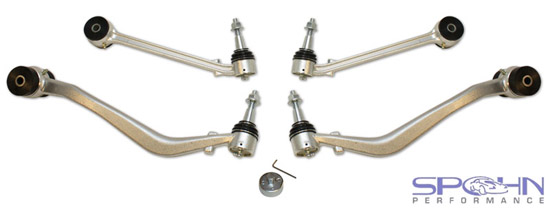
The Spohn arms have been on the market for a while now, and a few of the G8 owners have found that the poly bushings were deforming. I was able to get replacement delrin bushings (free of charge) from Spohn before getting them installed, so hopefully I will not have any issues.
* * * * * * * * * * * * * * * * * * * * * * * * * * * * * * * * * * * * * * * * * * * * * * * * * * * * * * * * * * * *
* * * * * * * * * * * * * * * * * * * * * * * * * * * * * * * * * * * * * * * * * * * * * * * * * * * * * * * * * * * *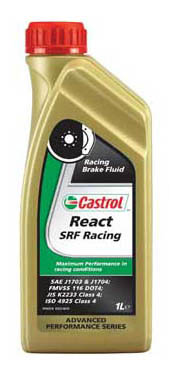
Before heading to a track day it’s always a good idea to have your brake system inspected. I’ve been running a nice DOT4 fluid (Motul 600), which is has a 593°F dry and 420°F wet boiling points. Normally I would have just replaced the fluid with new, but a friend of mine gave me a couple bottles of Castrol React SRF fluid to tryout.
Castrol SRF is some absolutely crazy brake fluid, despite costing ~$75 per liter! Most brake fluid absorbs water from the air… decreasing the boiling point of the fluid (aka. wet boiling point). The formulation of SRF is less hygroscopic than most, absorbing less water, resulting in a much higher wet point point of 518°F. As a result you don’t need to replace the SRF as often because the performance “drop-off” isn’t as significant as with other fluids as it ages and absorbs water.
While I was having the brake system worked-on, I also wanted to change out the brake pads for some that are more suited for track use.

After talking with someone running the same brakes as me, I decided to use Hawk HP+ pads up front and Hawk HPS pads in the rear. While these pads will be a bit noisy on the street, they will hold-up the the heavy use on a race track… especially with the weight of the G8 and the higher speeds that result from a supercharged engine.
Driving home from the shop it was apparent just how much initial bite these new pads have. It took far less pressure on the brake peddle to get the car to stop. When applying more than 3/4 brakes the front ABS even started to activate. It took a little getting use to, but I think I’m really going to like these pads on-track.
Now that the G8 has received it’s check-up and is ready for the track, I can focus my attention to the logistics of driving my own car on-track (rather than a school car)!
-
Miller Motorsports Park: Day 3
Posted on March 30th, 2012 No commentsI’ve completed the third, and final, day of this course… and now I want to go back to the beginning again! I felt that I’ve really improved my driving, but at the same time really neglected an important aspect of things (more on that later).
Today we started the day back on the “East Course” with another van ride. This time we talked about taking several different lines through each of the corners… passing, defending, etc. We also started talking about places that are good (high percentage) and bad (low percentage) passing areas. This set the tone for the rest of the day, which was very focused on “the art of passing”.
For the first on-track session was a lead/follow, but this time I found myself behind the wheel of the FR500S. Unlike the school car I’ve been driving for the past two days (Mustang GT), the FR500S is a purpose-built race car!
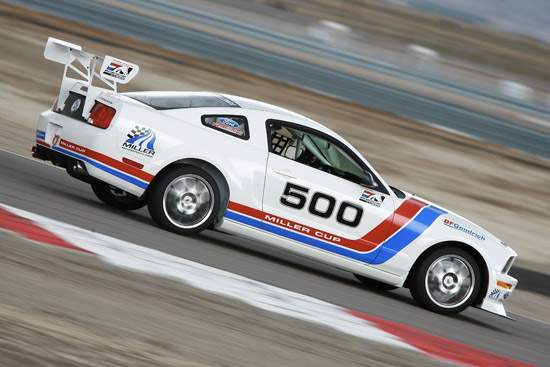
The other cars had roll cages and race seats, but the FR500S is in a whole different league… there is no AC, no AM/FM stereo, no interior, etc… heck, the steering wheel is removable! To start the car you have to turn a master electric cut-off switch, flip switches (ignition, AIM, etc.), and push a button… there is no key. After the first session I even had to ask someone how to turn the darn thing off!
While getting into/out of the FR500S was a bit tricky, the mechanics setup the car with a race seat that fits my larger hips (Sparco EVO3). The car also had a 6-point harness, which despite having a belt in your crotch, was extremely comfortable. After spending the day in this seat/harness I would not hesitate installing this same setup in my car for track days.
On-track the FR500S was MUCH quicker than the school Mustang GT. Being ~350lbs lighter it was a little faster down the straights, but it was in the corners that it really shined… I was easily able to carry 10-15mph more speed in most turns. It didn’t take me long to really start to like Turn 7 (Agony & Ecstasy). By trail braking into the center of the corner, I could carry lots of speed on entry without sacrificing corner exit.
For the second session of the day we were sent-out on track solo. The FR500S had no passenger seat, so all of the instruction was done from outside of the car. Because of this, I’m really glad that I did not elect to use it yesterday… I never would have learned about my breaking issues. Also, with the better cornering abilities of the FR500S, much of the resulting understeer would have been “masked”.
After lunch I learned that the FR500S that I’d been driving in the morning had developed a mechanical issue (some warning light came on or something). They gave me another one to drive, but not just any car… Roger Miller’s car (as in Miller Motorsports Park). Thankfully I was able to keep it on the track, as it would have been difficult to explain how I wrecked the track owner’s son’s car.
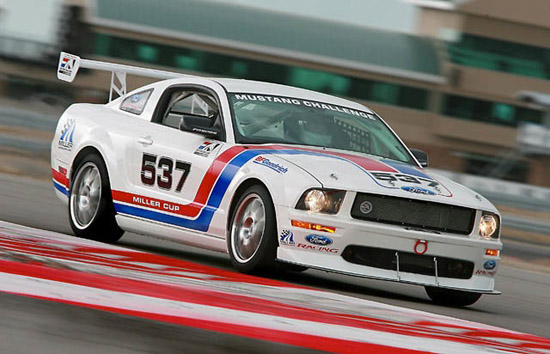
When we headed back out on track it didn’t take long to realize that all of the reference cones had been removed! After having always looked for cones, it was a little strange not having the references… but as time progressed I felt it made things easier. Without cones to fixate on I found myself “scanning” more. I was less focused on hitting a “perfect” apex than driving a smooth line through the corners. During this session I also discovered I could carry WAY more speed through Clubhouse Corner (Turn 13) than I would have ever believed.
Most of the past two days have been spent trying to navigate the track on my own. In session #4 the instructors joined us on-track and started challenging us to drive with another car in close proximity. It is much more difficult to focus on driving a smooth line when you have another car filling your mirrors, and too easy to overdrive a corner trying to keep-up with faster cars. During this session we also worked on the idea of setting-up a pass, even if it took several corners to manifest.
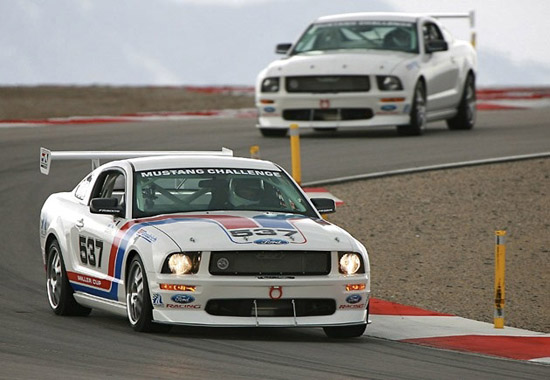
When driving in close proximity I started to learn just how much proper gear selection makes. The second half of the day I was constantly catching cars in the corners, even if I didn’t want to, but due to “being stuck in 4th gear”, just couldn’t pass them on the straights.
All of the instructors were giving me great complements on how smooth my driving was. This is good, as that was what I was focusing on, but I realized that I need to become more familiar with a manual transmission if I ever want to get faster on-track (in a non-automatic car). This is why I wish I was back at the first day of the school again… I’d really start to practice on getting smooth with shifting (including heel-toe downshifts).
The last on-track session of the course was focused on close-quarters driving. Most sessions start with the cars spaced evenly around the track, but this time we all went out in a group! For many laps we were running 3-4 cars nose-to-tail around the track. It really is an exhilarating feel driving full-speed through a corner only inches away from another car you’re not even looking at (other than your periphery).
The car that I was following was taking a dramatically different line than me through several of the corners, so there were many times we crisscrossed on the track. It was really fun to poke my nose under his in a corner, just to let him know I was there. For maybe 8 laps I would close-up in the corners only to be pulled away from on the straight. If it had been a racing situation I’m sure I would have been able to intimidate the other driver into making a mistake… In reality, I should know how to shift properly and just left him in my wake after a lap or two.
Just before the end of the session I pulled through the pits to get some clean driving room (surprising my Father who was watching from trackside and thought I might have gone off-track someplace). I took these last few laps to really practice driving a perfect line, without any influence from having a car in front of me. After the final checkered-flag flew I headed into the garage to park the FR500S for the final time of the day.

Looking back over the past three days I really felt satisfied about my progress as a driver. I also felt motivated to come back to a school after I get some more practice with a manual transmission. Hopefully I’ll be able to figure-out a way to get back out to Miller Motorsports Park in the future, as the past three days have been awesome!
Note: All on-track photos are “stock” and are not of me driving. There was no photographer trackside, but I felt some photos would make things look more exciting.
-
Miller Motorsports Park: Day 2
Posted on March 29th, 2012 No commentsTwo days down and one to go! After spending another day on track I’m feeling more comfortable and confident, but I am still reminded (quite often) just how much more I have to learn!
Today started out with a van session on the new track… Yes, the new track! Unlike yesterday where we were on the “East Course”, today we headed over to the “West Course”
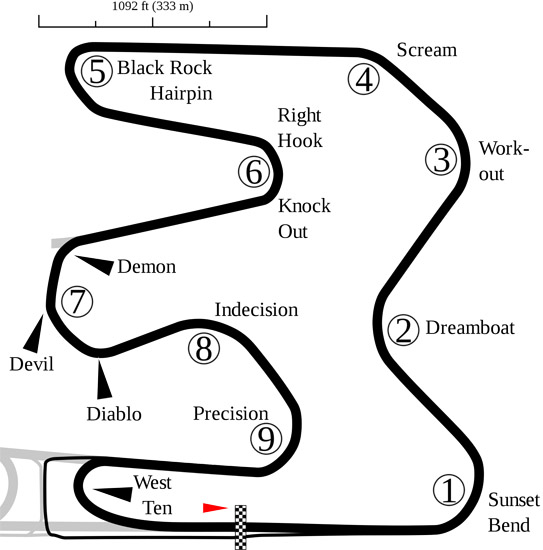
Being on a new track for the second day was really different than any of the other schools I’ve done. Yesterday I was getting fairly good at the “East Course”, but not being able to pick-up from where I left-off was challenging. I was able to learn a fair amount from the van ride, but it took me a while to get this new course down.
The first on-track session was a lead/follow at a fairly slow pace. Not only were we learning a new track, but the temperature was ~40°F (aka. cold) and there were couple wet spot on the driving line. I’m getting better at picking-up the driving line after a couple laps following someone.
In the morning we had another chance to get into the skid car for some additional practice. This time the car was setup with very little grip. When driving into a corner the car didn’t want to turn (understeer), but when you started through the corner the rear-end would step-out (oversteer). I was doing quite well at balancing things, but got a bit overconfident. When I started to drive the other direction into an off-camber corner, around I went… at least there were only two cones stuck under the car!
Today we had only a single lead/follow session, and for the second session I ended-up going solo the entire time. It didn’t take me long to get a good feel for Turns 1 through 4, but I was having a really difficult time with Turn 6. I kept turning-in too early, making the corner into a “V” rather than a smooth arch. After letting one of the faster cars past, I observed their driving line and noticed just how long they stayed against the outside curbing before turning in (midway between “Right Hook” and “Knock Out”). Once I saw that line, I was able to make the adjustment and I started taking the corner much better.

Unlike the “East Course”, the “West Course” is very flowing. The first few turns link together and really encourage you to carry speed through corners. Once you start your turn-in for Turn 3, you very quickly get back into the throttle and carry it all the way into Turn 5. The speeds felt much faster than yesterday, but I never once thought to look down at the speedometer.
While it was fun to blast into Turn 5, I often times found myself not slowing down enough, and the more time I spent on track, the worse it became…
After lunch we again headed out on track, but this time I had my first passenger! Having an instructor riding along really helped me learn, but for this session they were with me at the start of the session. I found that while I was driving slow I was able to maintain a good line, but when I started to pick-up the pace (as the tires warmed-up, etc.) I would start making more and more mistakes. While I learned from the instructor, it would have been nicer to have them ride along later in the session (when I was making the mistakes).
My real problem area was getting the car turned-in for Turns 5 and 10, both really slow corners, because I was trying to go too fast. Late in the fourth track session of the day I had an instructor in the car with me and he noticed I was not applying enough brakes at the start of the braking zone… and as a result wasn’t getting the car slowed-down enough before turn-in (which is why I was always pushing through the corners). For the remainder of the session we worked on getting the car slowed-down, and I really gained a better understanding of just how slow those two corners are.
In the last session of the day I took the knowledge I gained throughout the day and tried to put it all together. I did a much better job slowing down into the corners, resulting in driving a much better (and smoother) line. It was very rewarding to see things come together so well, compared to the first sessions on-track it was night and day!
The final session was also very fun because I spent it chasing-down another car. While for most of the time we weren’t nose-to-tail, I was able to judge our distance to figure-out where I was driving faster/slower.
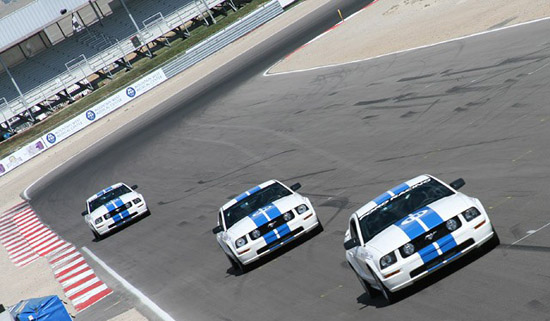
During this session I was doing such a great job in Turns 7 through 9 that I was able to get quite close to the other car going into Turn 10, but driving the course in 4th gear… he was running away from me onto the front straight. I was then able to catch back-up into the breaking zone for Turn 5, but would again loose ground coming out of the slow corner (‘sigh… 3rd gear would have been nice).
At the end of the day, I was very impressed with the progress I made. Towards the end I was consistently running good laps. I’m having a hard time remembering if there were any corners in the last session that I really butchered.
Tomorrow is the final day of the school, but we will be returning to the “East Course” to apply everything we learned today. I’m really looking forward to getting back onto this track, especially since I get to drive the Mustang FR500S!
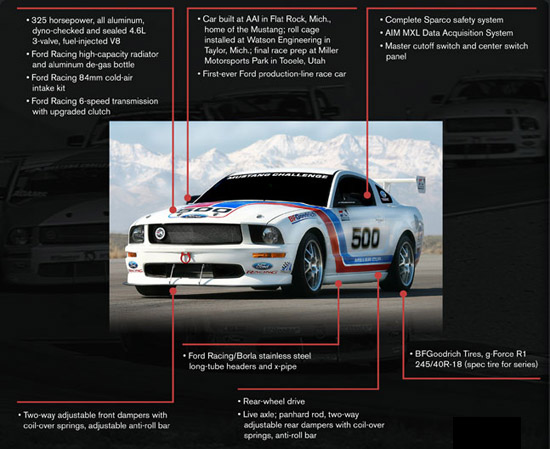
-
Miller Motorsports Park: Day 1
Posted on March 28th, 2012 No commentsDay 1 of our 3-Day course at Miller Motorsports Park is in the books and boy was it a hoot!
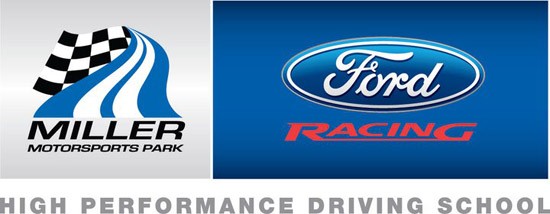
The day started out like many of the previous schools I’ve done, with morning introductions and some classroom time. All of the other schools were in street clothing, but this time we had full driving suits! It took a bit of time to get everyone into the right sizes, but we quickly headed out to the garages to get into our cars.
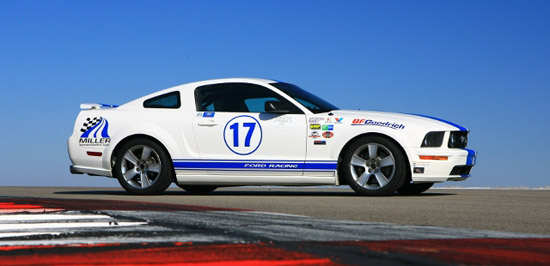
The Mustang GT is the main vehicle used for the course, and other than a few minor modifications (roll cage, race seat, 4-point harnesses) they are mostly stock. The seats in the cars (Sparco Evo2) is a little narrow for my hips, but wasn’t too bad. After a few laps (and cinched down harnesses) I felt well supported.
After getting into our cars we headed out onto the “East Course” for a lead-follow session. I found it really nice to get out on track so quickly, even if it was at a slow pace. Just being able to take a couple laps really helped get an idea of the course, and it paid-off later in the day.
The first drill of the morning was a session of heel-toe downshifting. Like my previous courses, these weren’t my best moments. Fortunately I’m starting to get a little better with the manual transmission. After some practice I was even able to string together a few good heel-toe downshifts! For the rest of the day (and the week) I will be spending my time in 4th gear focusing on my driving line. Maybe one day I’ll get the hang of this heel-toe thing, but it’s not going to be now.
After the downshifting we headed to the skid car for some laps around the paddock. Like last time, it was a total blast. Being able to experience a car with understeer or oversteer in a controlled environment was priceless. I seriously think that all drivers should get behind the wheel of a skid car… even if it’s only once, the experience will help them understand what to do when a car starts to skid.
There were only 6 students in our course today, which resulted in 2 students per instructor! With almost private instruction, I found it fairly easy to learn the track. It also allowed for lots of open space on track to practice, without having to worry about the car in front of or behind you.
Our first real session on track was two cars following an instructor. We started slow and really focused on driving the proper line. After a few laps the two trailing (student) cars switched places and we did a few more laps. We continued like this, switching back/forth, for ~20 minutes before heading back into the paddock. By the end of the session I was really starting to understand some of the nuances of the track.
After lunch there were three more track sessions on the “East Course” configuration.
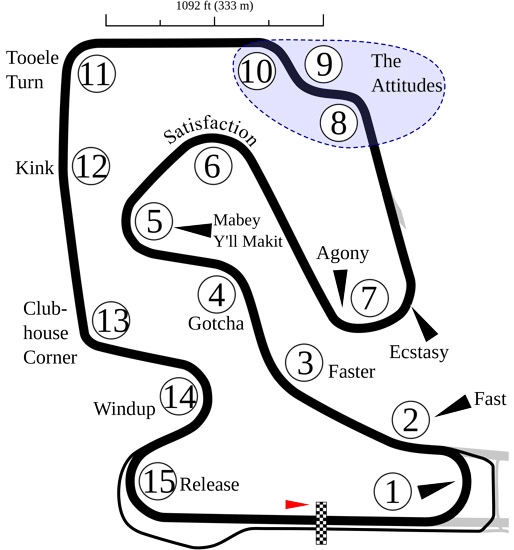
One session was another lead-follow. The other student in my group was at a similar pace as me, and it made for a lot of fun. We started out slow, but it didn’t take long for the speeds to start to increase… by the end of the session we were probably running about 60% pace of what I was eventually do today (not bad for the second session).
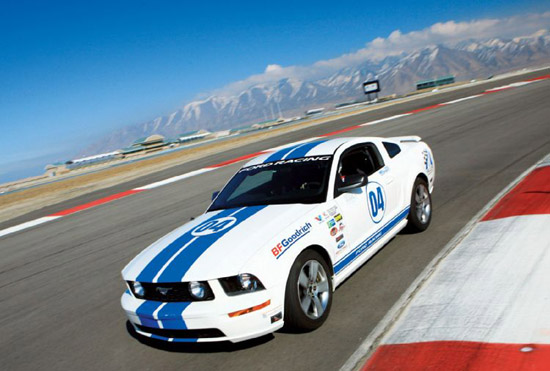
The third and fourth sessions for me were solo. The plan was to have an instructor ride along for a period of time, but it seemed that I was doing well enough that they focused on some of the other students a bit more. It was a little awkward not getting a ride along, but it was also nice to know that I was doing things well enough to not raise any black flags.
I tend to be fairly good at self-critiquing how I’m driving and will often times pick-up on mistakes and try to fix them on the next lap. There were still quite a few places where I made errors, but none of them were too major… and I think I’m getting a good feel for how to prevent them.
I know I have a difficult time judging closing-speeds when entering a corner, and a few times I fell into the trap of trying to drive too fast into a corner. This resulted in a poor line through the apex and a slow exit… one time I even went through the first corner so hot that I induced oversteer (one potential downside of trail braking) and ended-up “drifting” along the rumble strip at the edge of the track! While it was fun, it was a little embarrassing. I think I just need to take it a little slower to make sure I’m getting a good exit out of the corners.
Overall I was very happy with the way today turned-out. I was able to pick-up the new track fairly quickly and felt my car control was improving. Tomorrow we head to the “West Course” to learn another new course… I can hardly wait!
Oh yeah, my Dad had fun too!
-
Miller Motorsports Park
Posted on March 27th, 2012 No commentsThis next week is going to be a real treat… not only am I going to be doing a 3-Day driving school at the Miller Motorsports Park (MMP), I’ll be doing it with my Father!
The school doesn’t start until tomorrow, but we headed out to Utah yesterday afternoon. It was great to get in early and have some time to relax a little. We also took advantage of the extra time to scope-out the MMP facility.
One of the really unique features of MMP is the Larry H Miller Auto Museum. Businessman and automotive enthusiast, Larry H Miller helped lead the development of Miller Motorsports Park. One of the buildings has been filled with some of the most impressive and historic street and race Fords anywhere.
Many of the cars are 1 of 2, 1 of 6, 1 of 10, etc… the first race Cobra, the last race Cobra… the list goes on and on. This is the only place in the world that has a Ford GT40 MkI, MkII, MkIII, and MkIV under the same roof!
The car that really stood for me was the 1964/1965 Cobra “Daytona Coupe” (CSX 2299) that propelled Bob Bondurant and Dan Gurney to victory in the ’64 24hrs of LeMans.

The car would then go on to win the ’65 24hrs of Daytona and 12hr of Sebring. Bob Bondurant and Dan Gurney would continue on to drive Daytona Coupes to the FIA World Manufacturer’s Championship. If that’s not impressive enough, the current value is estimated at over $7.25 million!
After walking through the museum we headed into Tooele, UT to get some lunch at Sostanza Grill. While staying in Tooele last year, Sostanza was a staple… there was no way we were not going to eat there this trip! It didn’t take more than 5 minutes for the owner and several of the other employees to come over to say hello… it was great to see everyone again. With all the good food, I know we will be returning several times this week!
It will be an early night tonight, as we need to be up early tomorrow for the first day of our driving school. After a couple hours of auto-related programing on TV it’s time to get to sleep!
-
Bondurant vs Spring Mountain
Posted on February 11th, 2012 No commentsI have been asked several times, “which school should I go to… Bondurant or Spring Mountain?” While it is difficult to directly compare the two schools, mostly because I took different courses at each, I will give it a shot.
First I must say that you can’t go wrong with either school. Both schools offer incredible instruction on-track and in the classroom and will make you a better driver. The skills taught at the schools are very similar, and will provide the proper foundation for the future.
The Bob Bondurant School of High Performance Driving is located in Chandler, Arizona (~18 miles South of Phoenix). Courses are offered in various Corvettes (Grand Sport , Z06, or ZR1) as well as Camaros. There are also courses that include driving a Formula Mazda.
The track at Bondurant is 1.6 miles long and has 15-Turns. During the 3-Day course the track is broken-down into parts (Maricopa Oval, Lake Loop and Carousel, Full) making it a little less daunting. Also, with the shorter laps, I was able to work on a section of corners lap-after-lap… making learning the track a bit easier. The corners are fairly tight/technical with lower overall speeds (the whole track can be taken in 3rd gear).
One of the really great things about the Corvettes at Bondurant are the racing seats and harnesses. I’m a large guy, but never felt uncomfortable in the seats. The harnesses were very effective at keeping me secure while pushing the car through the corners… based on this experience I will likely be adding racing seats/harnesses to my car for track days.
The instructors at Bondurant were great, and really challenged me to push beyond my initial comfort level. They were also very accommodating of various driver skill levels (like my ineptitude with a manual transmission). The instructor-to-student ratio (one instructor for every 3 students) allowed for lots of one-on-one time. Because we were the only people using the course at the time it seemed like the on-track sessions lasted forever, which was nice when you were working on learning a specific corner.
The 3-Day Grand Prix Road Racing course at Bondurant was a bit more expensive, but included a couple extras (graduation plaque, T-shirt, sticker, etc.). They also have a staff photographer who can provide photos of your course on a Bondurant branded USB thumb drive. One thing not included was lunch, but it also allowed for some time off-site to clear your mind.

Pros:
- Racing seats and harnesses
- 1 Instructor per 3 students
- Hotel included with multi-day courses (Corvette Forum discount)
- Higher course price (even after 15%-off Corvette Forum discount)
The Ron Fellows Performance Driving School is located at the Spring Mountain Motorsports Resort, in Pahrump, Nevada (~50 miles outside of Las Vegas). Courses are offered in various Corvettes (Grand Sport , Z06, or ZR1) or Radical race cars.
Spring Mountain Motorsports Ranch is a true oasis in the desert. With a luxurious clubhouse, condos, pool/hot tub, fitness center, etc. it is almost everything you could want in a resort… with a race track thrown in! Catered lunches are included with your course (and breakfast as well if you’re staying in a condo). While Pahrump is a few minutes up the road, I only wish there was a restaurant on-site for dinners.
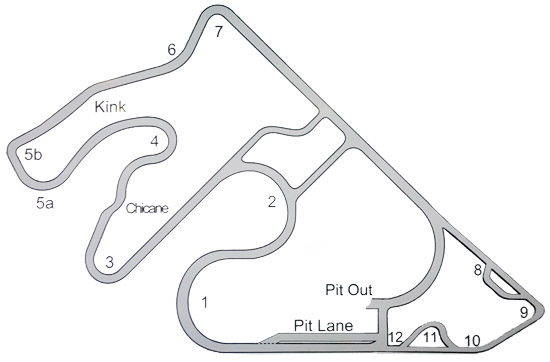
The track at Spring Mountain has multiple configurations, but for the Level 2 course was 2.4 miles long with 12-Turns (the Level 1 course runs the 2.2 mile configuration). The circuit is quite a bit larger with lots of long flowing corners (the whole track can be taken in 4th gear). The back straight is long enough for the horsepower difference between the Corvettes to really become evident.
The best learning aid available to the instructors is the 2-way radio system. While the instructor is leading/following they are constantly in contact via the radio, providing real-time tips… it’s practically one-on-one instruction. Especially with the longer laps, it makes learning the track much easier.
The track time was broken-down into 15-20 minute sessions, which allowed us to recover/debrief often. With the larger/faster track and no race seats/harnesses I felt myself getting fatigued… so having a little time to regroup between sessions really maximized the time being spent on-track. The last session of each day was a “cool down” where we focused on driving the perfect line. While it was a great way to practice driving the racing line, I’d have liked to had another “full speed” session (especially only being in a 2-day course).
I’d have to say that the instructors at the Ron Fellows school really make the experience incredible. I worked with several different instructors throughout the course, and found it helped, as each instructor had a slightly different view of things. All of the instructors are extremely friendly and really go out of their way to make sure you’re learning, but most of all… always having fun.
 Pros:
Pros:- In-car 2-way radio system
- Lower price (with 10%-off Corvette Forum discount)
- Level 2 and level 3 courses
- Stock seats and belts
- 40 Miles from “civilization”
Now time for a shameless plug… If this post was beneficial in your decision making process, please let the schools know when you book your course. While I wrote this, and all of my posts, for my personal satisfaction… the schools have incentives for referrals. Just think… the more courses I attend, the more posts I can make!




